Jenolan Caves House
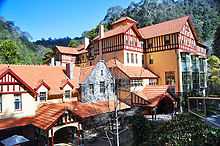
Jenolan Caves House is a large, historic hotel, built in stages between 1879 and 1926. It is located in the remote Jenolan Karst Conservation Reserve, Blue Mountains National Park, on the western edge of the Blue Mountains World Heritage Area, in New South Wales, Australia.
The building was designed in the Government Architect's Branch of the New South Wales Public Works Department, under the supervision of Colonel Walter Liberty Vernon (1846–1914). The 4-storey complex was designed in the 'Arts & Crafts' style, of which Vernon was an advocate.[1] Parts of the building show the influence of the 'Sussex Wealdon' style, in particular the half timbered upper facades of the later sections. The building is characterized by gables, tile roof and deep recessed openings with multi-paned windows.[2] The building was constructed to provide accommodation for visitors to Jenolan Caves (previously known as Binda Caves or Fish River Caves), one of Australia’s most extensive limestone cave systems (karsts) that is open to the public.
Early Development by Jeremiah Wilson - 1879-1895
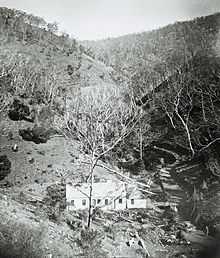
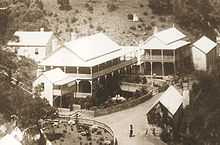

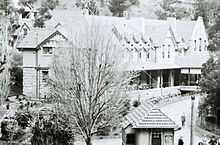
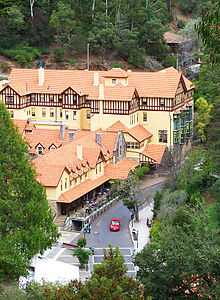
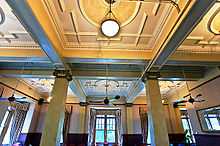
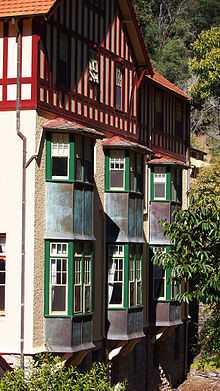
Although long known to local Aboriginal people, Jenolan Caves was not discovered by European settlers until the early 1800s.[3] The area was declared a protected reserve for tourist purposes in 1866. A local farmer, Jeremiah Wilson, was appointed 'Keeper of the Caves' in 1867.[4] Visitors would write to Mr Wilson advising him of their intention to view the caves. Meeting them at Tarana railway station, he would convey them by horse-drawn vehicle, 54 kilometres (33 miles), through Oberon, and then walk them down the last 5 kilometres (2 miles) into the Jenolan Valley, because the decent was too steep for a vehicle.[5] In an early Jenolan Caves guide book, the difficulties posed by the remote location were summed up by J. J. Foster, who said, "The want of good roads, and the dangers of these perpendicular mountains, also the great want of an accommodation house, mitigated for years against this district becoming a popular place for tourists, or a holiday resort. At the time, all provisions had to be carried there by the visitors, and it was necessary to camp and sleep on the rocks under the Grand Arch."[6]
In 1879, Wilson built a small kitchen building. The following years, he was able to erect a single-storey, wooden building, roofed with corrugated iron. This first ‘Caves House’ contained 5 bedrooms and a large dining room. The kitchen remained separate, in case of fire - a common risk at the time.[7] In 1886, the fee for an overnight stay was only 2 shillings ('1st Class') or 1 shilling ('2nd Class'). A horse could be stabled for 6 to 8 shillings per day. Or it could graze in the adjacent paddock for sixpence per day.[8]
In 1887, Wilson erected a two-storey wooden building, catering for 30 visitors, and characterised by deep verandahs around 3 sides of both levels.[9] Thate year, New South Wales Governor Robert Wynn Carrington, 1st Marquess of Lincolnshire, and his wife, rode 45 kilometres (28 miles) on the new Six Foot Track from Katoomba, staying 2 nights in this early Caves House building.[10]
During 1888, there were 1,829 visitors, making further accommodation necessary.[11] Therefore, in 1890, Wilson demolished the original small kitchen. In its place, he erected a 2-storey wooden building, alongside the original main building. He built it in the same style as the 1887 building, with deep verandahs on both levels. By then, reflecting the more comfortable accommodation, tariffs had risen considerably to 10 shillings per day for adults and 5 shillings per day for children and servants, with 'cave costumes' available for hire.[12]
A new road from Katoomba, via Hartley, offered a more direct route, with travelers alighting at Mount Victoria Railway Station.[13] The horse-drawn coach cost 30 shillings one way or 40 shillings return. This meant that a visit to the caves and a stay in Caves House was still out of the economic reach of the ordinary person.[14] In February, 1895, Prince Francis Joseph of Battenberg stayed the night at Jenolan Caves House and inspected the caves.[15]
Unfortunately, the following month, fire destroyed the new 1888 building, as well as the earliest accommodation house, kitchen, billiard room and 2 dining rooms.[16]
Rebuilding by Walter Vernon - 1896 to 1898
In 1896, Walter Liberty Vernon, was engaged to design a new Caves House, adjoining the 1887 building (which had survived the fire) on the footprint of the original building that was destroyed in the fire. The Director of the Royal Botanic Gardens, Sydney, Joseph Henry Maiden, remodeled and terraced the slopes around Caves House, providing a setting of park-like gardens.[17] The improvements cost the NSW Government £30,000[18] which would be equal to more than AUD$4.5 million in 2013.[19] The new 2-storey building held a dining room for 60 guests, a billiard room, accommodation for 50 and the latest kitchen and bathroom innovations.[20] It was built from the 430 million years old Silurian limestone[21] quarried on site at Jenolan. This building is now known as the 'Vernon Wing'.
Final Stages of Development by Vernon and McRae - 1906 to 1926
In 1906, the 2-storey, verandah-wrapped, wooden building, which Wilson had built in 1887, was demolished. In its place, in 1907, a second wing was added, perpendicular to the 'Vernon Wing'. This new 2-storey wing was also designed by Vernon, but supervised by his successor George McRae.[22] It contained sitting rooms, dining rooms and 26 guestrooms. It was also made of local limestone and roofed with red, French tiles.[23]
In 1916, a massive 4-storey wing (133 feet long) was completed by McRae, from plans designed by Vernon before his death. This wing provided 60 extra guestrooms, lift, dining room and large kitchen.[24] In 1926, the 4-storey wing was further extended, adding further guestrooms and, in particular, expanding the dining room. This extension cost £6,937 (equal to AUD$5,065,219, as at 14 August 2013[25]) and was built by W. J. Bailey of Oberon.[26]
Historical Points of Interest - from 1917
Newspaper articles from 1917 to 1947 describe the popularity of Jenolan Caves House after The Great War,[27] producing meat and vegetables from its own farms nearby.[28] Australia's youngest recipient of the Victoria Cross medal, Private John Jackson, spent Christmas 1918 there.[29] In 1919, a deluge completely submerged the ground floor.[30] During the Spanish Influenza pandemic of 1919, Caves House was closed for several weeks and used as a convalescent home for nurses who had become infected.[31] In January 1926, highly decorated British Field Marshal Edmund Henry Hynman Allenby, 1st Viscount Allenby and his wife stayed overnight at Jenolan Caves House.[32] In 1927, England’s Prince Albert Duke of York and his wife, Lady Elizabeth Bowes Lyon, Duchess of York (later King George VI and Queen Elizabeth The Queen Mother) stayed overnight at Caves House.[33] In 1942, Caves House was nearly forced to close, due to war time transport problems.[34] However, 1946 saw a travel boom, during which the facility accommodated 32,500 guests.[35]
Heritage Listing in 2004 - Cultural Significance
In 2004, Jenolan Caves House (along with the caves) was listed on the NSW State Heritage Register, having been identified as meeting a range of standards - historical, associative, aesthetic, social, research potential and rarity - which make it significant for past, present or future generations.
Aesthetically, the appearance of Caves House, with its roots in English provincial building practice, is a contrast to the mountainous landscape of the remote Jenolan Valley, its massive limestone arches and craggy cliffs. As the building is the work of a prominent colonial architect, who was influential in the development of Australian architecture, Caves House attains significance by association. Historically, Caves House illustrates the considerable human activity and ingenuity necessary to provide accommodation in the early days of Australian tourism, in buildings especially designed for this purpose. Vernon had to employ innovative methods to address problems posed by a major building project in a remote setting. Also, Caves House was built to service one of the earliest protected sites of natural environmental heritage in the world, declared a protected area by the New South Wales government in 1866. Lighting and sewage developments dating from the late 1880s are of significant historical importance, as they were crucial to the development of the remote area as a tourist destination. Caves House has the research potential to provide archaeological evidence about the early development of New South Wales tourism. Along with the caves, it is a rare example of the development of mountain and cave tourism in New South Wales.[36] Also, of historical significance is the fact that in 1889, to provide electricity for the caves (and later, Caves House) Australia's first hydro-electricity plant was built nearby.[37]
Socially, it is significant that, initially built for the wealthy, Caves House became much more accessible over the years, especially after public motor transport became widely available, exemplifying the growth of social homogeneity in Australia.[38]
Today, Caves House still operates as a hotel, with café, bar, function rooms and restaurant. Members of the public can stay there or wander through the large public rooms, which retain much of their Edwardian ambiance.
References
- ↑ Boyd, N., No Sacrifice in Sunshine, Walter Liberty Vernon: Architect 1846-1914, PJHD Thesis, published by School of Architecture & Design, RMIT University, Abstract
- ↑ Moore, Robert, The Caves House Precinct, Jenolan Caves Reserve: Conservation Plan, Volume 1, New South Wales Dept of Public Works, Architectural Division, Public Building Branch, 1988, p. 40
- ↑ Trickett, O., Guide to the Jenolan Caves, Sydney, Aust., W.A. Gullick, Government Printer, 1905, p.21
- ↑ www.jenolanhistory.org.au, Keepers of the Caves, Jenolan Caves Historical and Preservation Society, accessed 14 Aug 2013
- ↑ Morning Bulletin, 12 Jan., 1885, 'A Visit to the Fish River Caves', Rockhampton, Aust., p. 5, col. 2
- ↑ Foster, J. J., The Jenolan Caves, Sydney, Charles Potter, Government Printer, 1890, p.2
- ↑ Low, J., Blue Mountains Pictorial Memories, Kingsclear Books Pty Ltd, 2005, p. 103, accessed 14 Aug, 2013
- ↑ The Sydney Morning Herald, Sat., 8 May, 1886, 'The Jenolan Caves', Sydney, Aust., p. 15, col. 6, accessed 14 Aug, 2013
- ↑ Low, J., Blue Mountains Pictorial Memories, Kingsclear Books Pty Ltd, 2005, p. 103, accessed 14 Aug 2013
- ↑ Nepean Times, 10 Sept., 1887, 'Katoomba', Penrith, Aust., p. 4, col. 3
- ↑ The Sydney Morning Herald, 11 June, 1889, Sydney, Aust., p. 7, col. 1 (2nd paragraph from the bottom), accessed 14 Aug, 2013
- ↑ Foster, J.J., The Jenolan Caves, Sydney, Charles Potter, Government Printer, 1890, p.2
- ↑ Morning Bulletin, 12 Jan., 1885, 'A Visit to the Fish River Caves', Rockhampton, Aust., p. 5, col. 2, accessed 14 Aug., 2013
- ↑ Foster, J. J., The Jenolan Caves, Sydney, Aust., Charles Potter, Government Printer, 1890, p. 2
- ↑ Evening News, 'Jenolan Caves - Visit of Prince Joseph', 23 Feb., 1895, Sydney, Aust., p. 5, col. 6, accessed 14 Aug, 2013
- ↑ Bathurst Free Press and Mining Journal, 14 Mar., 1895, 'Fire at Jenolan - The Old Buildings Destroyed', Bathurst, Aust., p. 2, col. 4, top of column, retrieved 13 Aug., 2013
- ↑ www.environment.nsw.gov.au, NSW State Heritage Register, 'History - Historical Notes', accessed 13 Aug, 2013
- ↑ The West Australian, Sat., 16 Feb., 1901, 'Our Caves - Official Visit of Inspection - Accommodation Houses', Perth, p. 9, col. 2, accessed 14 Aug, 2013
- ↑ In 1898, the Australian pound was linked to (and worth the same as) the British pound. Using the historic currency converter, www.moneysorter.co.uk/calculator_inflation2.html#calculator, GBD£30,000 in 1898 was worth GBD£2,726,206.90 on 14 Aug 2013. Using the currency converter, www.ozforex.com.au/currency-converter, to convert to Australian dollars on 14 Aug 2013, the value of £30,000 was more than AUD$4.6 million.
- ↑ The Australian Town and Country Journal, Aug. 20, 1898, 'The Jenolan Caves', p. 30, accessed 14 Aug, 2013
- ↑ www.dbforms.ga.gov.au, Australian Government Geoscience Australia, Australian Stratigraphic Names Database, accessed 21 Aug., 2013
- ↑ www.environment.nsw.gov.au, New South Wales State Heritage Register, History - Historical Notes, accessed 14 Aug., 2013
- ↑ The Sydney Morning Herald, 14 Jan., 1908, 'Caves House at Jenolan', Sydney, Aust., p.5, col. 3, accessed 21 Aug., 2013
- ↑ The Sydney Morning Herald, 25 Apr., 1916, 'Buildings and Works - Progress of the Trade - Caves House Jenolan', p. 4, col. 4, accessed 21 Aug., 2013
- ↑ Using the historical currency calculator, www.rba.gov.au/calculator/annualPreDecimal.html
- ↑ The Bathurst Times, 30 Apr., 1925, 'Local and General - Jenolan Caves Tenders', Bathurst, Aust., p. 2, col. 3
- ↑ The Sydney Morning Herald, 31 Jan., 1917, 'Jenolan Caves', p. 6, access 13 Aug., 2013
- ↑ The Sydney Morning Herald, 14 Jan., 1918, 'On the Land - Farm at Jenolan', p. 5, access 13 Aug., 2013
- ↑ The Sydney Morning Herald, 1 Jan., 1918, 'Orient Cave at Jenolan', Sydney, Aust., p. 3, col. 8, accessed 14 Aug., 2013
- ↑ The Sydney Morning Herald, 28 Feb., 1919, 'Caves House Suffers', Sydney, Aust., p. 6, col. 4, accessed 14 Aug., 2013
- ↑ Evans, S., The Influenza Pandemic in the Blue Mountains (and Lithgow), Historical Society Occasional Papers, No. 1
- ↑ The Sydney Morning Herald, 21 Jan., 1926, 'At Caves House', p.11, col.4, accessed 22 Aug., 2013
- ↑ The Mercury, 22 Feb., 1927, Hobart, Aust., 'The Royal Tour', p.7, col. 4, accessed 13 Aug., 2013
- ↑ The Sydney Morning Herald, 25 June, 1942, 'Tourist Hotels to Close', Sydney, Aust., p. 4, col. 3, accessed 14 Aug, 2013
- ↑ The Sydney Morning Herald, 10 Mar., 1947, 'The Great Holiday Boom Causes Many Problems', Sydney, Aust., p. 2, col. 3 & 4 , accessed 14 Aug., 2013
- ↑ www.environment.nsw.gov.au, New South Wales State Heritage Register, 'Assessment of Significance', accessed 14 Aug., 2013
- ↑ The Sydney Morning Herald, 25 Dec., 1889, 'A CHANGE has been made...', p. 5, col. 2-3, retrieved 23 July, 2013
- ↑ Moore, Robert The Caves House Precinct, Jenolan Caves Reserve: Conservation Plan, Volume 1, Sydney, New South Wales Dept of Public Works, Architectural Division, Public Building Branch, 1988, p. 68